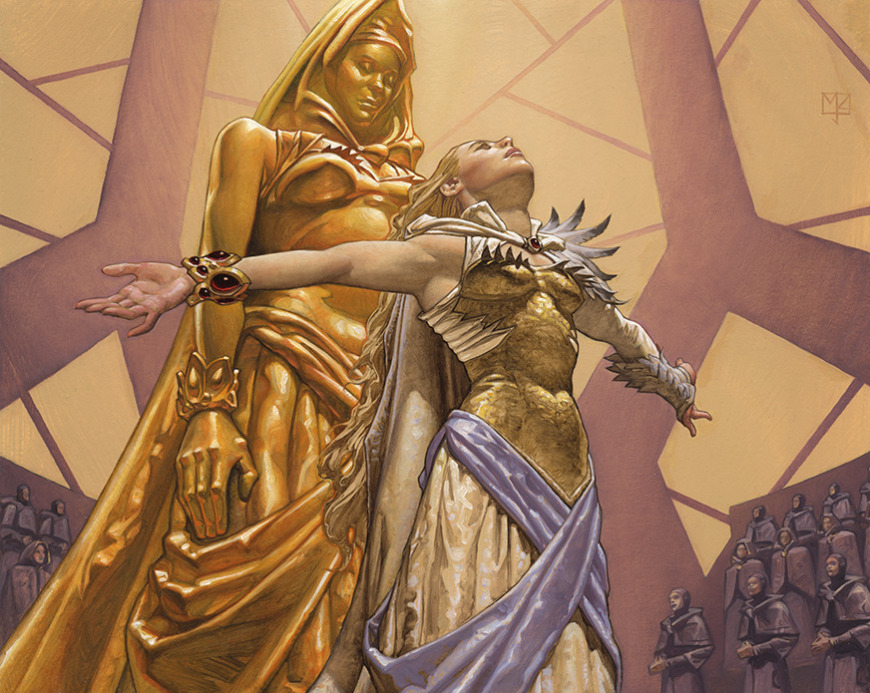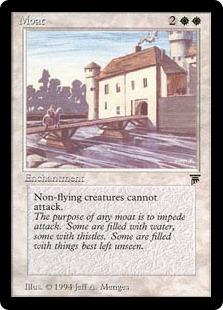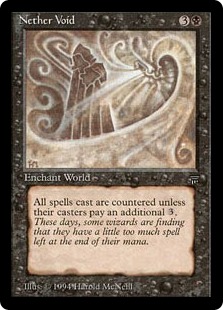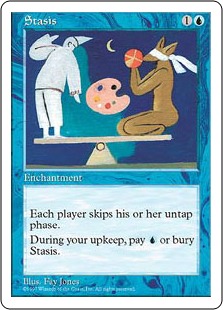Hello, and welcome to this edition of Sullivan’s Satchel. Even though we’re perpetually in Preview Season™, some stand out to me more than others. It is with great excitement that I’ve watched some of the initial Modern Horizons 2 cards come down the pipeline. I worked on it a fair bit, maybe more directly than any other set since I’ve started working on Magic. It’s also the set where I got to work most directly with Aaron Forsythe. He’s my biggest influence (in terms of communicating with the public as well as game design) of anyone over there. Even in a short amount of time I learned even more.
The non-Standard releases are also interesting exercises in that the goals and process are different, but that doesn’t mean you abandon any notion of a “set.” Structure still matters, Draft certainly still matters, but designs get to be a lot more “targeted,” although sometimes they’re priced in to be adjacent to pre-existing designs (flavor beat, callback to an iconic design, etc.). I loved it. I hope to get to do similar work again. In the meantime, seeing the stuff start to take shape into real cards is exciting, professional highlight, all that.
With that, the questions. As always, you can send in yours to [email protected] or DM on Twitter @BasicMountain. If your question is even reasonable it will probably be answered here. The best question, as determined by my sole discretion, will receive $25 in SCG credit. This week is special in that nobody won last week, so we’re rolling it over into a 50-ball.
From Friend of the Satchel™, Ben Seitzman:
Great question. There are so many good ones to choose from, for positive and negative reasons. Everything is a learning process and it’s usually more instructive to take from the bad than the good. With that, there are two masterpieces I would have loved to observe firsthand.
Arabian Nights: Compared to Alpha (the only thing they had to go on at the time, remember), the places in which the set is powerful are so much better and sustainable than the previous set. In terms of the card drawing, mana acceleration, and destructive interaction that define most of Alpha, only Library of Alexandria really fits into that ideology. In its place is a significant upgrade in the quality of creatures — Juzam Djinn, Serendib Efreet, even stuff like Whirling Dervish and Erg Raiders are a significant upgrade on the previous stuff (maybe too drawback-heavy in the aggregate, sure). Was this an intentional push or did the team not understand the relative insignificance of the drawbacks in question? Fascinating stuff, such a wild deviation from the previous set. That’s not easy to do in the second set of a game with no previous analog to draw inspiration from.
On a separate thing, the first set only contains basic and dual lands as lands. Arabian Nights has a bunch of lands that don’t make mana (Bazaar of Baghdad, Diamond Valley); lands that make colorless mana (Library of Alexandria, Desert); and one land that makes all five colors of mana (City of Brass). The creativity shown in exploring the design space of lands (very easy to default into just making them simple cards, like in Alpha) is an incredible achievement, and a huge step forward in Magic design that still resonates today.
Magic 2010: A masterclass of design from Aaron Forsythe, Matt Place, and a number of other all-stars in reinvigorating Magic and getting it back to simple, resonate, flavorful designs after years of opaque play patterns and power in unappealing places. The confidence and belief in vision to make Baneslayer Angel the marquee card shows faith in the vision.
This set put Magic back on solid ground. I doubt the past decade’s nonstop growth would have happened (at least in terms of degree) without it.
From Peter Leja:
I don’t think it’s inherently bad to have a card type that’s difficult to handle at a baseline. First, that reality is something the design team has agency over. Things like Dromoka’s Command or moving enchantment removal to black are examples both in the micro and macro of influencing the degree to which they’re unassailable.
Second, giving people a relatively stable card type to build around, assuming the power level and play pattern are in the right place, has merit. Doom Foretold is a great example. It’s splashy and encourages a bunch of novel cards, the card has a fair bit of counterplay baked into it even if the opponent can’t destroy it, and it probably wouldn’t be worth building around if you could reasonably expect most of your opponents to blow it up fairly easily. I consider that example to be a success for the card type.
The issue is that Magic is littered with examples of it going the bad way. Too many enchantments are single-card soft and/or hard locks that lean into the fact that people can’t kill them easily. Moat, Nether Void, The Abyss, Worship, Stasis, Counterbalance, Rising Waters, etc. It’s worth noting that most of these examples are quite old. Even in Magic’s relative infancy there was an awareness from designers that this sort of space should be avoided.
I do think enchantments are the most replaceable card type; you could probably manage to capture the majority of the design space by collapsing them into artifacts. Other designers have made this point in the past. However, I don’t think the design space is problematic at a baseline with good practice from designers. Further, it captures some design space and tone that artifacts can’t. I would keep it around even with the opportunity to mulligan them.
From Indiana Jones:
I know the experience you’re describing with Lurrus. It’s been nice exploring Izzet Prowess in Modern since that card is explicitly off the table. Still, because Lurrus is so good with the stuff I want to play anyway (cheap creatures, Mishra’s Bauble, etc.), it’s very hard to justify not playing it. I’m not sure how much the card is homogenizing my experience overall. Like I said, part of its appeal is how it “forces” me to play cards I likely would anyway.
I feel the most stifled when the terms of engagement are very narrow. In Standard prior to New Phyrexia, there were a variety of ways for aggressive decks to engage with the challenge of Stoneforge Mystic into a Sword, plus some 1/1 flyers to back it up. Once Batterskull became part of the equation, trying to fight them with more expensive cards and more profitable (but clunkier) interaction became impossible, and so my deck became nothing but the cheapest creatures and whatever Shocks were lying around. Pretty boring. Oko, Thief of Crowns had so much loyalty, and invalidated text boxes so thoroughly, that the only thing to do was to figure out how to dump the most power onto the battlefield as soon as possible. Combo decks that don’t rely on creatures engender this experience as well.
Lastly, the Question of the Week, and winner of $50 in SCG credit, from Eric Wong:
I have two formative memories as far as this goes:
Chad Hastaba, 1995, Type I Tournament, Edison NJ: This was at the old Grey Matter events run by Brian David-Marshall, my first forays into competitive Magic. This was before Organized Play was super-formalized, so the best (or most commonly used, at least) measuring stick was your DCI Elo rating. Chad was a Top 10 Type I (now Vintage) player globally, though who knows what that really meant in practice. I played “Bant” and had very little power. We were both 1-0 or maybe 2-0 in the tournament as this point. He made fun of me for Disenchanting his Mox Emerald on my second turn. Then he didn’t play a third land and died. I couldn’t stop talking about this victory with my friends for months. It’s still one of my fondest competitive memories.
David Humpherys, 2001, GP Boston, Round 4: This was my first Grand Prix, Invasion/Planeshift Sealed. I won a huge Trial the night before for three byes, but it ended at 4 AM and I couldn’t get back to the hotel room. I registered my Sealed deck and fell asleep at the table. When I woke up for my pairings, my sideboard had been stolen.
Then I saw I was paired against David Humpherys, then one of the ten or so best players on the planet. He very quickly dispatched me 2-0 behind Flametongue Kavu and Crypt Angel, and was generally good-natured and polite even though I’m sure I was obnoxious and overly chatty.
Losing didn’t feel great, but I did have the experience of feeling like the game wasn’t any different even though I was playing against someone so good, who had a level of success I was dreaming about. He took some damage, respected the possibility I could have a trick, sometimes seemed like he was weighing options, maybe in a bit of a bind — it was the same game, and I could throw my jabs with him. Not as fond of a memory as the first one, but maybe more important for my trajectory towards playing on the Pro Tour, which I did for the first time less than a year later.






